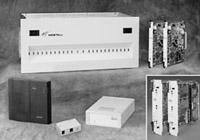ADSL Internet at home quickly and economically
1999/11/01 Waliño, Josu - Elhuyar Fundazioa Iturria: Elhuyar aldizkaria
When spoken by phone there are several frequencies that are not used to transmit voice. This route was studied by the initiators of the development of ADSL technology in 1996. Currently this technology is a reality and it seems that the year 2000 will be the year of the ADSL.
What is known as ADSL (Asymmetric Digital Subscriber Line) uses the normal telephone line of our home to connect to the Internet. It distributes the line in three channels: on the one hand it leaves a channel of communication of voice and, on the other, it prepares two channels of high speed for the connection to Internet: one for the collection of data and another for the sending of data. Both channels are asymmetric, that is, the data collection channel is faster than the shipping channel.
The reason for asymmetry is clear: The amount of information received from the Internet is not the same as the one sent, since it receives much more than what is sent. The ADSL technology is, therefore, based on the need to receive information quickly.
Features ADSL

Although a modem is used to connect to the Internet through ADSL technology, it is not a normal modem. Analog modems capture the entire home phone line to connect to the Internet and can't be spoken by phone while connected. In addition, analog modems currently achieve a maximum speed of 56’6 kbps. However, with ADLS you can speak by phone while connected to the Internet, as this technology uses different channels for voice and data. As for speed, as discussed above, two speeds will be obtained: A speed of 8 Mbps can be reached at the data reception and 1 Mbps at the data shipment. However, for the moment, the services in operation in Spain reach a maximum speed of 2 Mbps, but this speed is faster and cheaper than that offered by the RDSI itself (digital network).
These are not the only advantages of the new service: When connecting via ADSL the type of on-line connection Always is used, that is, it is not necessary to make calls to connect to the Internet, just to display the program available for the browser or mail and will be connected automatically. This will avoid a major obstacle so far: Most of the problems that arise in Internet connections are errors in the connection call. If this were not enough, the use of ADSL allows you to connect to the Internet for as long as you want, since in short a fixed monthly amount will be paid, since the payment method of this service will be the system called flat rate. In addition, the cost of the regular phone and the ADSL service fee will be included in the telephone bill.
What is needed to have ADSL at home?
As always, it seems that the new system will only be for Windows at the moment. ADSL modems that have been made so far are not compatible for Macintosh, but they say they will be soon. As has already been indicated, a special modem is required to connect to the normal telephone line, but it must be taken into account that this modem will not serve to send faxes as the fax moves from the normal voice line.
The ADSL connection is currently only offered by Teleline. At the moment it is not very cheap, but in the long term, and especially for Internet users, it will take an important step. Teleline currently offers three services: the cheapest of them offers 256 Kbps data collection speed and has a flat rate of 9.300 Pts/month. To this must be added the ADSL modem (26,680 sts.) and the works of high and installation (30.740 ptas., which offer free until 31 November).
As has already been indicated, this service can at the moment represent a cost for most home users, but it is clear that it has secured success. It's clear!

Gai honi buruzko eduki gehiago
Elhuyarrek garatutako teknologia





